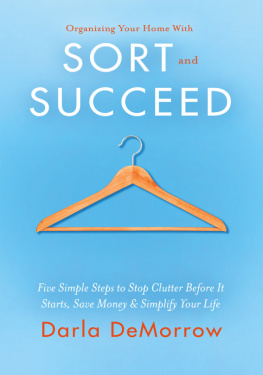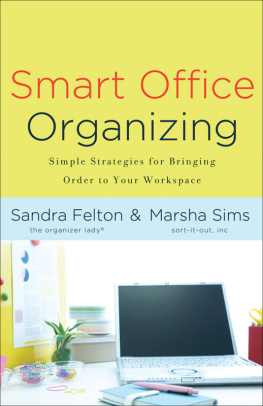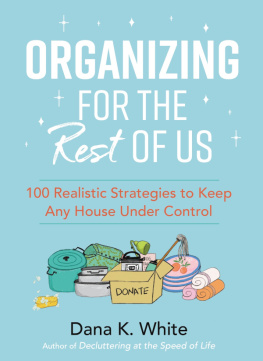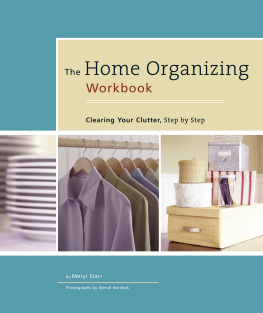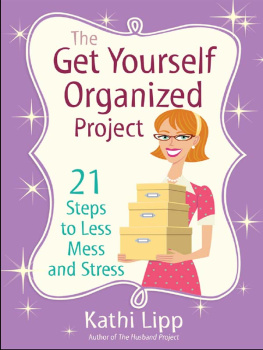ORGANIZING
SOLUTIONS
FOR PEOPLE WITH ADHD
Tips and Tools to Help You Take Charge of Your Life and Get Organized
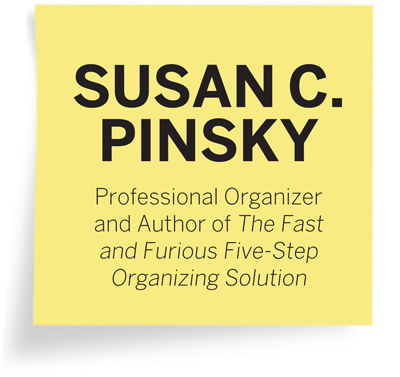
This book is dedicated to my husband, David Pinsky,
whose love and support make everything possible.
INTRODUCTION
Early in my career as a professional organizer, I was hired by a vivacious and talented part-time artist whose home was among the messiest and most disorganized I had ever seen. We worked together one day a week to organize a space or set up an organizational system, but when I would return the next week, all would be undone. I would then have to waste valuable time re-addressing the old problems before we could move on to new ones. I could not, for the life of me, understand why this intelligent and capable artist had a harder time than other clients maintaining the spaces and systems we had worked so hard to organize. Ironically, the answer to this question came from within my own family.
I came to the study of organizational solutions for people with attention deficit hyper-activity disorder, or ADHD, out of necessity rather than design. My eldest daughter was diagnosed with ADHD when she was a fourth-grader. Up until that time, I had comforted myself with a series of excuses to explain away her difficulty managing her schedule and possessions. I alternately told myself that she was undisciplined, she was an absent-minded professor type, or our parental expectations were alternately too lax or unreasonably high. But eventually it became clear that through no fault of ours or hers, my daughter struggled to stay focused on even the simplest of tasks.
A METHOD IS BORN
Not surprisingly, my jobs as a professional organizer and as the parent of an ADHD-afflicted child soon began to overlap. Based on what I was learning about ADHD, I was able to rely on my expertise as a professional organizer to weigh, adopt, reject, or modify organizational systems that could help my daughter. Conversely, my newfound knowledge of ADHD led me to recognize that along with the aforementioned female artist, many of my chronically disorganized clientsand sometimes a clients chronically disorganized spouse or childwere exhibiting what I now know to be ADHD behaviors and symptoms. I also discovered that the organizing systems I was using at home to assist my daughter were far more effective in the homes of these clients than the standard values, methods, and tricks of the trade I had previously used as a professional organizer. Over time, I was able to develop a clear methodology that responded to the specific needs of someone with ADHD, and soon my client base drew heavily from that community.
If you have ADHD and you struggle to stay organized, you may have asked yourself the following questions: How do I create an organized life when the repetitive tasks required for good organization are too tedious to engage my attention, and when my possessionseven important and expensive onesare constantly misplaced in moments of distraction? How do I live harmoniously with family members when my stuff tends to invade their space and my tardiness affects their schedules? These are discouraging questions, but let me assure you that good organizational skills are not beyond your reach. By re-examining some outdated values, simplifying your systems, refining your definition of organization, and adjusting some of your expectations, you can achieve a sustainable organized life.
This book is geared toward anyone whose life and home are affected by ADHD, which includes both ADHD sufferers and their frustrated family members striving unsuccessfully to keep an orderly home. It addresses those ADHD symptoms that stand in the way of organizingimpulsivity, distractibility, perfectionism, memory lapses, and procrastinationbut it also calls on the common strengths of ADHD sufferersenthusiasm, intelligence, ingenuity, and creativityto aid in the search for a more organized life. A word of warning though: these methods are not typical. They reject many worthy values while encouraging a slap-dash, get-it-done style that might feel very alien. But while our even better is the enemy of good enough mantra may seem shocking, I guarantee it gets the job done.
A NOTE ABOUT THIS METHOD AND EDITION
The ADHD method of organizing relies on efficiency above all other values; because organizational systems that suggest you spend a lot of time getting prepared for events that may or may not occur (protecting against possible but unlikely misfortune, creating multiple back-ups, and generally making everything beautiful or perfect) are disastrous for a population that has limited patience for maintenance tasks.
But I am going to tell you a secret: Since the original edition of this book came outnay, even before it was publishedI had started using these get-it-done fastand sufficiently (not painstakingly and perfectly) ADHD-appropriate methods with all of my clients. It turns out that any home that struggles with organization, whether because of illness, lack of time, multiple children, working parents, tight space, excess clutter, or an overcommitted scheduleand who doesnt have one of these stressors?should rely on a system that gets things done efficiently, with the least amount of time and work put in. After all, how many people really want to spend their time doing chores? I dont. (I even wrote a book about it, The Fast and Furious Five-Step Organizing Method, which gives anyone who struggles with organization a chance to master no-fuss clutter control.)
THE GOLDEN RULE OF ORGANIZING: INVENTORY MUST CONFORM TO STORAGE
When I make any home ADHD-style efficient, I follow a pretty draconian version of the golden rule of organizing: Inventory shouldnt just conform to storage but should be less than storage, so that it never requires a multi-step dance to put things away. Instead, every item should be stored where it is used so it can be stowed in one single motion. This not only makes the home sensible and efficient, it allows everyone to help out. That is, not only will my ADHD clients be able to pick up any room in their home in less than three minutes, but anyoneyour mother-in-law after Thanksgiving dinner or your eight year old after any mealcan help out, too. Indeed the house should make so much sense that a stranger could figure out where something belongs.
JOIN THE REVOLT AGAINST CONSUMPTION
The straightest, most effective path to achieving the golden rule of efficiency is reduction. We have to reducenot give up necessities, or even occasional luxuriesbut rather give up the cult of stuff that is destroying our homes, stealing our leisure time, wiping out our wallets, and killing the planet. In some cases, this may require weeding out technologies and other gadgets, both new and old, that are not helping us but instead interfering with our desire to lead a clutter-free life. (Note that this revised and expanded volume will also address technology that either didnt exist or had not yet come into its own when this book was first published in 2006, but we will still analyze all technologyboth new and oldthrough our prism of efficiency.)
I say we in this book because the super-efficient, simple, reduced system I have created for my ADHD clients is one I now use myself and that everyone who eschews materialism, treasures leisure time, and is concerned for the health of our planet should think of adopting. For this reason, in this revised edition, I have changed my callouts from you, meaning those with ADHD, to we, meaning anyone who cares about sustainable, maintainable organization.



